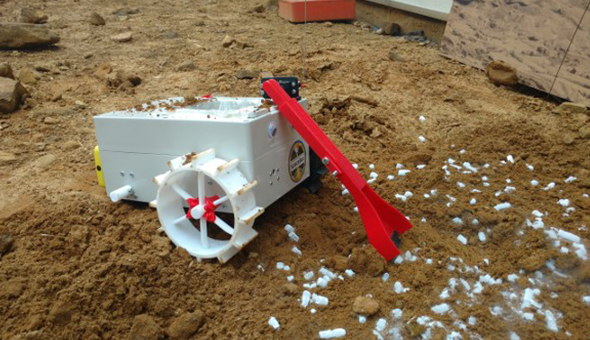Author: William Easdown -
July 16th marked the conclusion of the 2016/17 UKSEDS lunar rover competition. The five teams that made it through the rigorous design and evaluation process to the test day were from Bath, Bristol, Surrey, Cranfield and Manchester, and we all assembled at RAL Space in Oxfordshire for a long day of roving. The first hour or so was spent meeting the other teams and setting up our rovers, with Bath the first to be ready to head over to the testing yard.
Test area
The route we had to take across the Moon simulation test area would lead us from flat parts, over a steep mound and past more rocks to the sample collection point, where 500g of dry ice would be waiting for our scoop. The course was a good test of traction on the steep hills and ability to navigate over and around the rocks. We had planned to use our forward-facing camera to provide an extra point of view for navigation, but this proved unnecessary with the whole test area being within line of sight of the control point, and Wi-Fi connection problems rendered it unusable anyway.
First attempt
Unfortunately, shortly after starting our first run, we suffered a major setback when one of our rear wheels snapped at the join between the axle and hub due to low density 3D printing, quickly followed by the other. This made locomotion practically impossible as it meant dragging the rear of the rover over the rough terrain using only the traction from the front wheels. The organisers allowed us to carry the rover by hand to the sampling site to test our scoop, but with it raised so high off the ground by the low rear, it couldn’t dig properly into the sand. We managed to collect two chunks of the target dry ice along with a good amount of sand, but the dry ice was insufficient to register on the scales used for scoring.
Vibration testing
After the first run and before our pizza lunch in front of the cleanrooms, we had our vibration test. This used the large shaker table in the new R100 building at RAL Space to subject the rover to loads of up to 3G across a range of frequencies and amplitudes. It also went through sine and random vibration tests to simulate a variety of launch conditions. Everyone watching was amazed how resilient the rover was to the vibration thanks to its slightly flexible plastic chassis absorbing the shaking. Only a few screws worked loose or fell out, and most of these had been hand tightened initially. Even the googly eyes stayed attached!

Second attempt
We enjoyed the tasty pizza lunch that UKSEDS provided (paid for by Airbus Defence & Space) and used the break to get to know some of the other teams. There was a really friendly atmosphere and all the teams wanted each other to do well. Soon enough though, it was time for our second and final run. With the help of Aron Kisdi, one of RAL Space’s robotics engineers, we managed to glue and screw our broken wheels back together and added reinforcement to the remaining two and to our sampler arm. Our second run was more successful than the first, with our rover, nicknamed Steve, covering 6.4 metres rather than 3.2. The team and I were very pleased to have put forward a strong attempt when our rover was clearly much cheaper and simpler than most of our competitors. Eventually though, the wheels gave out again, and an attempt by me to use the sampler to jack the rover onto the remaining wheels caused the sampler bracket to snap too when I tried to drive forward.
Summing up
Ultimately, although our rover suffered some mechanical failures, the team and I are very happy with what we achieved on the day and throughout the whole design process since October. We’ve shown that Bath students are a formidable force in space engineering and can compete on a national stage, coming fourth overall in this year’s competition and doing particularly well on the vibration test. Congratulations go to Surrey EARS from the University of Surrey and CranSEDS from Cranfield University for their first prize and best CDR respectively, but we’re confident we can present an even better rover next year and will be aiming to take their crowns!
How to get involved
We're looking for lots of new people for the 2017/18 team, so if you'd like to take part you can message me (William Easdown) on Facebook, email me directly, or join the Space Society Facebook group and get in touch there. We mostly need mechanical and electrical engineers, but would also definitely welcome computer scientists and anyone who wants to help with our publicity or thinks they can contribute in some way. We'd like to say thank you to UKSEDS for running this very successful competition and to all the sponsors (RAL Space, Thales Alenia Space and Airbus Defence & Space) for their time and help with making the competition possible.
Respond

